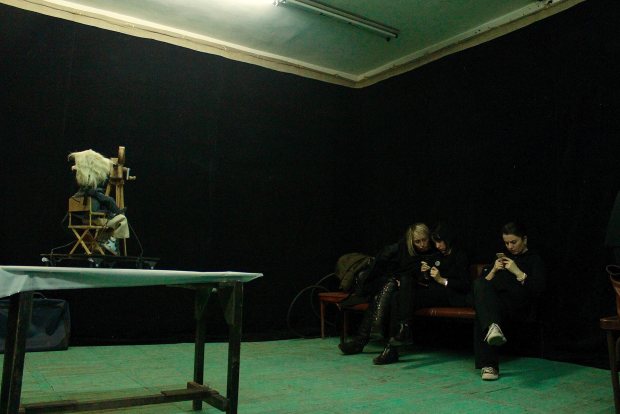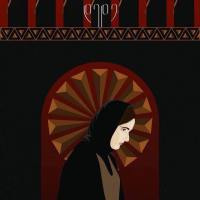Butterflies and Burning Sandcastles
One of the puppet theatres I had most wanted to contact was the Gabriadze Marionette Theatre. I had seen them perform in Paris and then again in Tbilisi and yet I never quite made contact. It was a disappointment since Rezo Gabriadze was one of the puppet directors I had most wanted to interview and Ramona one of the best puppets shows I had seen. But alas, one doesn’t get everything one wants.
Click on these for larger images.
I did however discover that there was another place in town, the Tbilisi State Puppet Theatre (TSPT), which has existed in one form or another since 1934. And so I late February I found a Facebook page for them and and sent them a message. I was contacted by Ana Sanaia, an actress and their manager. She was happy to have me come see them. I found them in an old factory building called The Silk Factory, where they had a small theatre. I was let in on a day when there was an art exhibition in an adjacent gallery. The Silk Factory was used for a variety of purposes including a production studio that I was shown, which might be a place where I can edit the final version of Gravity From Above.

Ana Sanaia Shows Me An Unfinished Puppet
I was enjoying a conversation with a woman named Salome Berikashvili when Ana Sanaia came in. She was very glad to meet me. The show for the day was a short version of Tbilisi’s history done through allegorical imagery. The play called Sakartvelo (Georgia) featured a modified bunraku style not too different from the Gabriadze Theatre. They performed mostly on a table top, with performers in black moving the figures from behind. The main figures were a wooden donkey and a bird. But whether cotton balls for clouds or flat cutout dancers or pails filled with sand and turned upside down, then lifted up to represent an older Tbilisi, the sense of invention was continual. The main director Nikoloz Sabashvili had come from the theatre but was bringing to the puppet stage a wider grammar. I was especially impressed when the sandlot Tbilisi was set ablaze, some inflammatory accelerant laced into the sandcastles and then the sandcastles were destroyed. The donkey and the bird were seeking a butterfly, Suliko, who represents the soul of Georgia. Suliko is also a Georgian song, which is heard several times in the piece. But just when it seems like the butterfly will return it is crushed by the frightening boot of Communism. But, and this was a similar theme to Budrugana Gagra’s Isn’t This A Lovely Day, the donkey ascends in a ladder into the clouds to find the butterfly in a heavenly place. And then everyone sings a song. And that’s a happy ending in Georgia. Looking forward to eternal life, rather than the life in this embattled world. I find I am often impressed by the deep longings, often thwarted, in Georgian stories.
The song Suliko ends with these lines:
Ah, life has meaning once more now!
Night and day, I have hope
And I have not lost you, my Suliko
I shall always return to you, I know now where you rest.
Watch this now… It’s only 5 minutes of your life.
I also attended a children’s show on another day. The narrator was essentially a large khinkali. Let me try to explain what I mean. Khinkali is one of the national dishes of Georgia. It is a ravioli-like dumpling stuffed with ground spicy meat or selguni cheese. So what I’m saying is that the narrator of this children’s show was a large dumpling. The story, which I must confess I didn’t quite follow, my Georgian language skills can best be described as infantile, but it did involve love, a journey of sorts, farm animals and an ogre. Or was that a demon? The children were as noisy as the French kids, happily clapping and singing along when there was a moment. And the house was so crammed full that I felt guilty for taking up one of the seats.
A couple of weeks later in March I was invited by Ana to see the actual studios and rehearsal space of the TSPT. I met her in the Marjanishvili Square area. While waiting for her I bumped into Nino Namitcheishvili who was directing a puppet show based on Antoine Exupery’s The Little Prince over at the Marjanishvili Theatre. I told her I would go in a week. Ana came along after Nino had gone and had also met her on her way to see me. Artistically Tbilisi is not a very big town. Most people seem to know each other or at least about each other. Ana took me into a strange old modernist building that I had seen from a far but never seen close up. The building felt partially deserted partially unlit. We took an aging elevator up about seven floors. I entered the ramshackle hall on the floor that was used mostly by the puppet troupe. I was allowed to visit the rooms where craftsmen worked making dolls. I also met a few women working on clothing and other artistic aspects of puppet creation. It was a suitably crowded and thriving hive of activity. In another room the various puppeteers were gathering to work on improvisations and scripts. I also saw old rare posters for past shows sitting in a huge pile. At one point a puppet of Woody Allen was brought out. Evidently Georgians have a fondness for the neurotic New Yorker. Although it was hard to imagine what a Georgian would sound like imitating Vudi Aleni.

ვუდი ალენი (Vudi Aleni) also know as Woody Allen.

Niko watches practice intently.
I was sitting in a moody dimly lit office with Niko Sabashvili watching a video he had directed in a theatrical manner that told a tragic Georgian political story of recent vintage. Ana Sanaia was there. She was also a potent actress within the film. Niko had to work on rehearsals when Salome came in. I told the two women about what had happened before this trip even started, losing my home of more than 20 years, receiving the backing of the International Institute of Puppetry in France at the beginning of this journey. As we spoke I also conveyed that I was starting to wonder if maybe I should relocate to Tbilisi. I had had several conversations that pointed me in that direction. They both looked at me seriously and told me at different moments: “You are supposed to be here.” There was something eerie about it. As though some direct word from above was coming through them. If I had been tilting towards the idea 60/40 when I walked in, I was even more thoughtful about the possibility when I left.

Like an Edward Hopper scene, Woody Allen looks on as puppeteers await practice.

The Tbilisi State Puppet Theatre Takes a Bow
















Pingback: Gravity From Above: A Personal Reckoning | GRAVITY FROM ABOVE